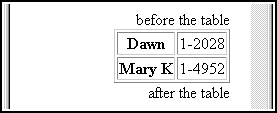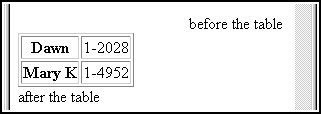Is the P Endtag Required?
W3C says of </P>: "The end tag is optional as it can always be inferred by the parser." This means that a new <P ...> implies the end of
the previous <P ...> (and any alignment set by the previous <P ...>).
Any other block level element, such as
<HR ...> or
<BLOCKQUOTE ...> should also end the paragraph. However, it doesn't always
work out that way. Some browsers, for example, will right-align the text even after a table. In the following example, MSIE renders the "after the table" part as right aligned, while Netscape renders is as left aligned:
<P STYLE="text-align:right">
before the table
<TABLE BORDER>
<TR> <TH>Dawn</TH> <TD>1-2028</TD> </TR>
<TR> <TH>Mary K</TH> <TD>1-4952</TD> </TR>
</TABLE>
after the table

MSIE's rendering |

Netscape's rendering |
If you set the alignment or other style property for a paragraph element it's best to use </P>. If you never use set any styles then you can generally ignore
</P>.
See W3C's specs for paragraphs for more information on this topic.
|